Preparation for a Journey
The fundamental focus of my practice is the way that materials, and the performative act of interacting with them through painting and paint-making, can generate meaning. Having developed my research into historical European painting techniques, a journey to China was an opportunity to travel through materials and uncover crossovers and divergences, materially and culturally. The journey, however, was to push me to far deeper, to reflect on how materials can inhabit the imagination.
I prepared by thinking about the materials I know to have arrived to Europe from China, the most obvious of which seemed to be paper. While great emphasis is often placed on the revolution of ideas precipitated by the invention of the Gutenberg printing press and the bibles and tracts printed on it, we in Europe often fail to remember that neither would have come about without the invention of paper. When the Arabs brought paper making from its original source in China to Europe via the silk route, they had to modify the method because of the availability of materials. In China paper was and is made with plant fibres such as mulberry bark, although in ancient times rougher papers were also made from old hemp ropes and sandals. Lacking plants such as the mulberry tree, the Western papermakers had to use fabric rags made from bast fibres. Thus, paper making became an elegant way to recycle old clothes. In the early modern period, the item of clothing that everyone possessed was linen or hemp underwear (cotton if you were from further south) in the form of a shirt or shift, compared to the most ubiquitous item of clothing these days, which is a pair of jeans.
I therefore set about making some Western style paper to take on my journey to China. One batch of paper was white, made from the off cuts of clothes were hand sewn by friends, members of an historical interpretation society called The Tudor Group. The rags came from various scraps of hemp and linen, including antique, hand woven examples. This paper therefore represents one that was possible in 16th century early modern Europe. The second batch of paper was blue and made from reject jeans from a Swedish denim company, Nudie jeans, that make jeans with organic cotton and dye this using as environmentally friendly techniques as possible. As a company that taps into the latest eco-friendly and ethical consumer trends, they were happy to give me their reject jeans for processing into paper.
This blue paper was reminiscent of the papers toned with indigo pigment used by artists such as Durer and Altdorfer - a process described by Cennino Cennini in his Craftman’s Handbook (1437). It caused me to think about the significance of indigo, as a dye-stuff carried by various species of plant around the world. It has a global presence and local significances. Particularly associated with work wear, it was the typical colour for servants' clothing in 16th century England, the colour of choice for the Zhongshan (or ‘Mao’) suit due to its link with Chinese peasant workwear, and of course, the colour of denim jeans originally worn by gold rush miners in California. Now, of course, it is a global fashion item. Furthermore, since the process for extracting and dyeing with indigo is extraordinary, it seems a testament to human ingenuity and experimentation that people have uncovered and worked with the mysteries of indigo all around the world - from South America with añil (indigofera suffruticosa), Europe with woad (istasis tinctoria), India with indigo (indigofera tinctoria) to China and South East Asia with several indigo-bearing plants such as dyer’s knotweed (polygonum tinctoria) and... yet another species of woad (istasis indigotica) of which I had not previously been aware and which was to surprise me on my journey!
My final act of preparation was to ask if it was possible for the team at Vitamin Creative Space to kindly grow some dyer’s knotweed (polygonum tinctoria) - otherwise known as Chinese Indigo - for me so that it would be ready for harvest when I arrived. Ironically, they had difficultly sourcing the seed, since the name was easily confused and lost in translation, so I had to post some seed to China from Britain. The team at Vitamin planted the germinated seedlings at an urban farm on the outskirts of Beijing called Little Donkey Farm, and members of the team regularly undertook the long journey across Beijing to tend and water ‘Lady Indigo’, as she became affectionately known. Little Donkey Farm runs a ‘Community Supported Agriculture’ programme which aims to promote ecological farming practices. Beijing residents can have fresh organic produce delivered and even rent patches of land to grow their own crops. Things move so fast in China residents of the big cities have managed to urbanise, become alienated and have a back-to-the-land movement in the space of just a few years. Yet, as I was to discover, in this vast country there are also many people living a far more basic lifestyle and whose choices and responses to these phenomenal changes are not what one might first expect, finding ways to gain status in maintaining local social and religious practices for example, and choosing not to become alienated in the cities in the first place.
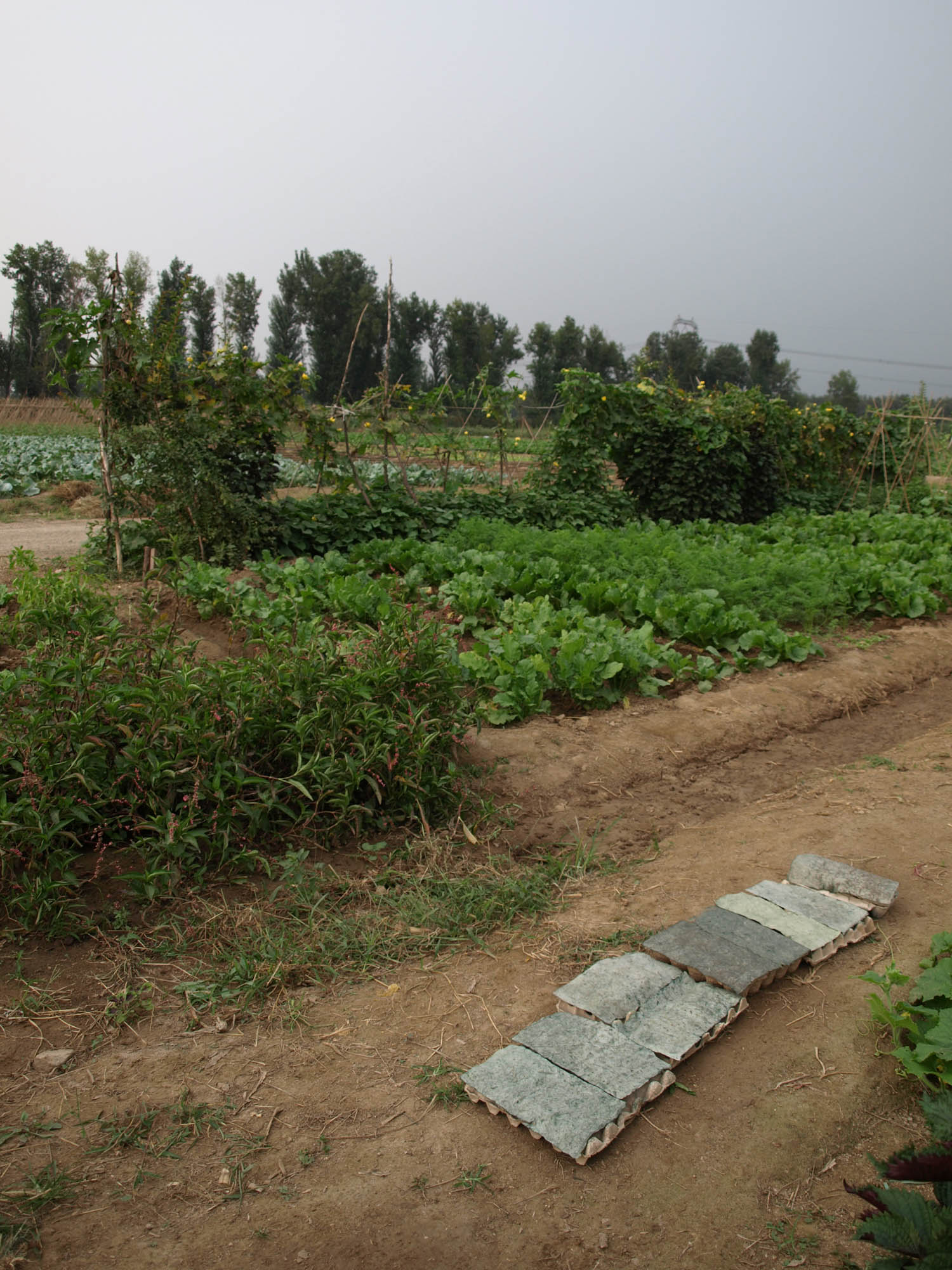
Lady Indigo growing at Little Donkey Farm with Dongba paper dyed blue with her leaves drying in the foreground.
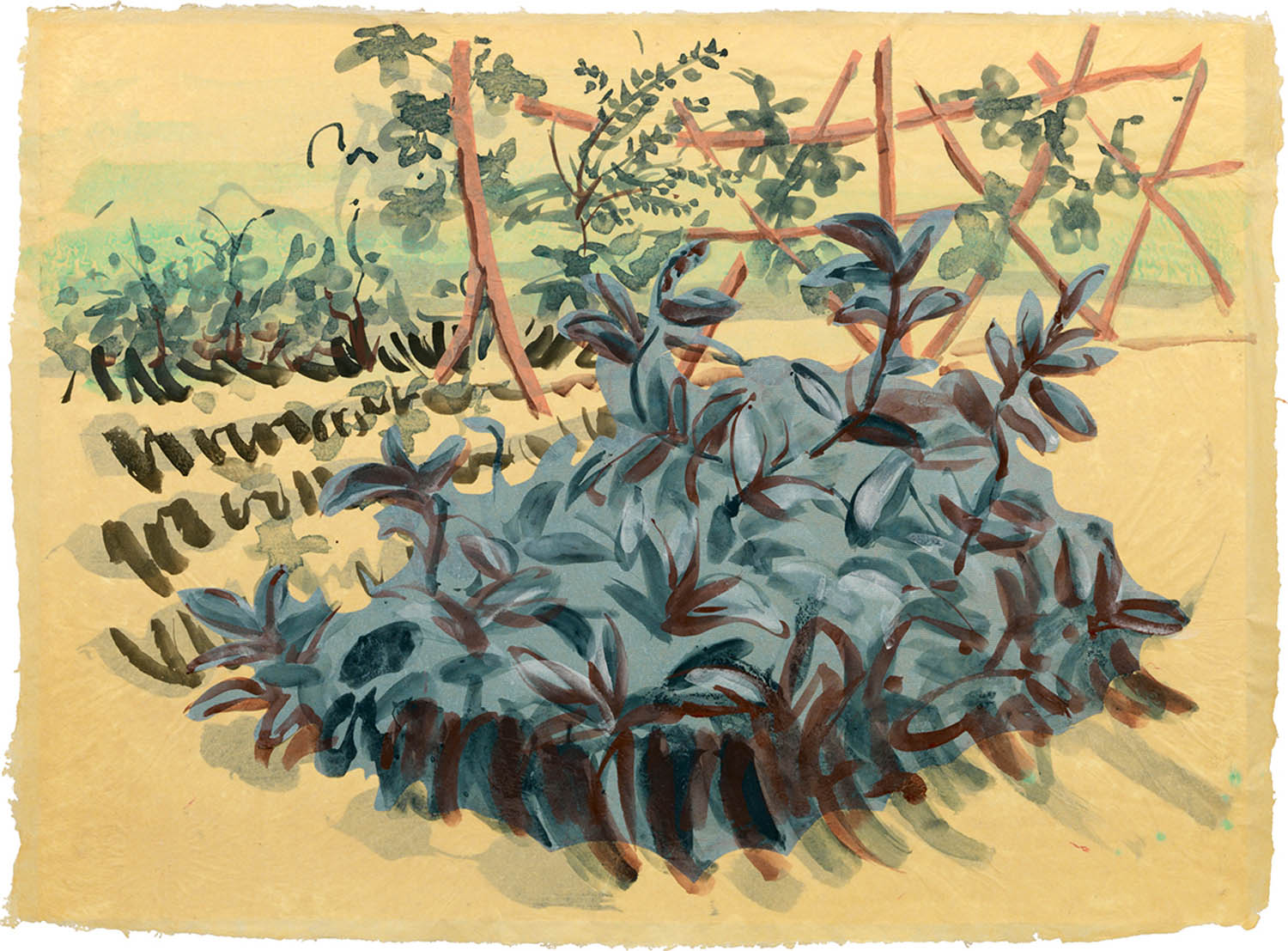
Sigrid Holmwood
Indigo growing at little donkey farm
2012
Yellow paper made from linen dyed with amur cork tree bark, blue paper made from linen dyed with indigo fermentation vat, and pink paper made from linen dyed with madder roots, painted with Chinese ink, caput mortuum, malachite, oyster shell white and indigo bound in parchment clipping glue.
52.5 × 74 cm
Journey to WuMu
Knowing that I had been working with paper, Vitamin thoughtfully organised a research trip to the province of Yunnan, to stay with the ethnic minority Naxi people in a village called WuMu, a four hour drive into the Yulong mountains. The Shamans of the Naxi religion, Dongba, must make their own paper in order to write their scriptures in their own unique script - the only known ‘living’ pictographic script in the world. The Dongba religion is believed to derive from the Tibetan animistic Bön religion and is based on the belief that man and nature are half brothers from the same mother, but with different fathers. Like every family, these brothers can get into disputes with each other and the role of the Shaman is to enact rituals that keep the balance between man and nature, and to guide souls on their path to heaven. The Dongba manuscripts, written on their handmade paper, are prompts for the enactment of these rituals, and the fact that the paper is made by the hands of the Dongba Shaman himself is of central significance.
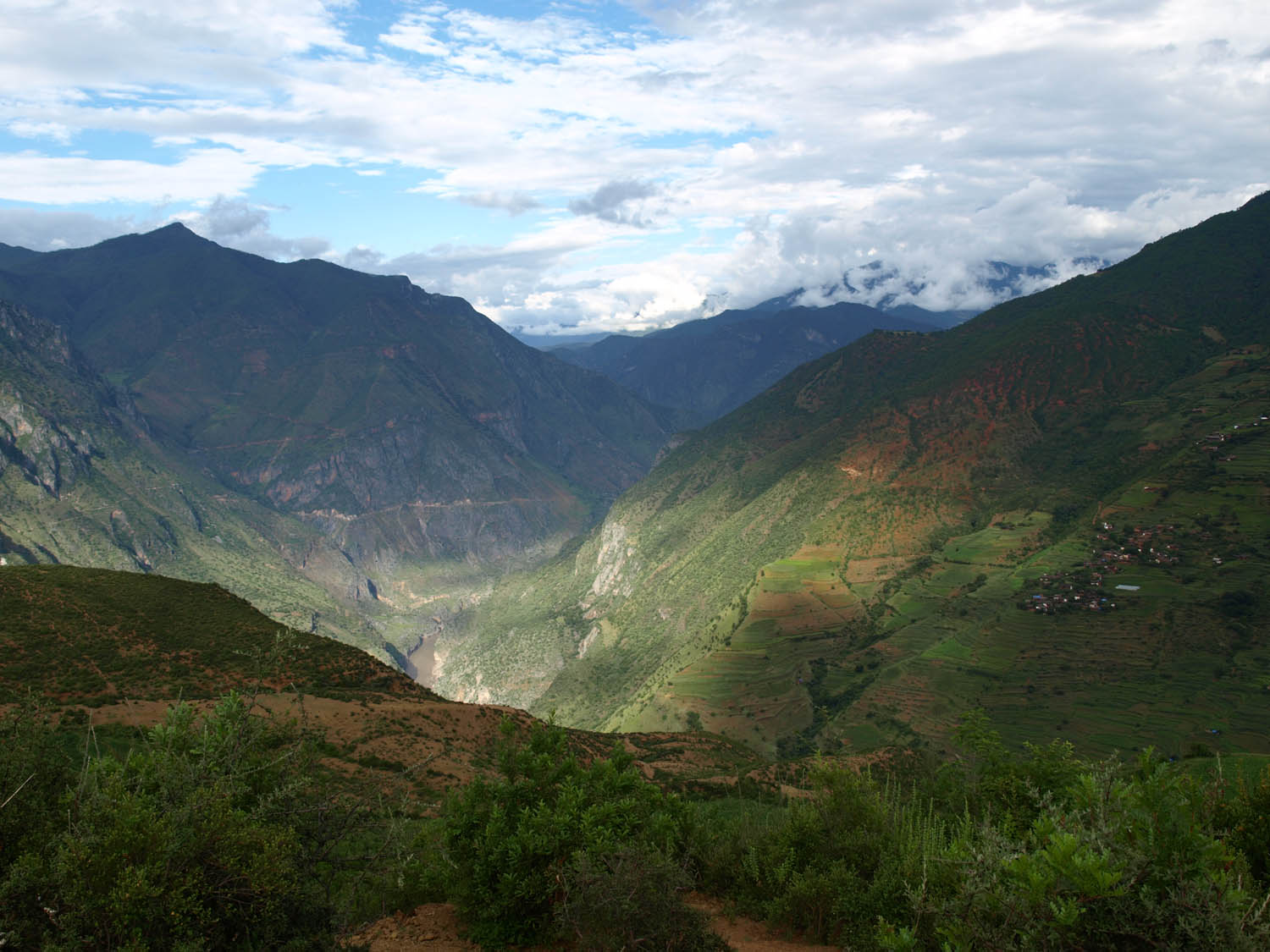
The Valley of Yulong Snow Mountain
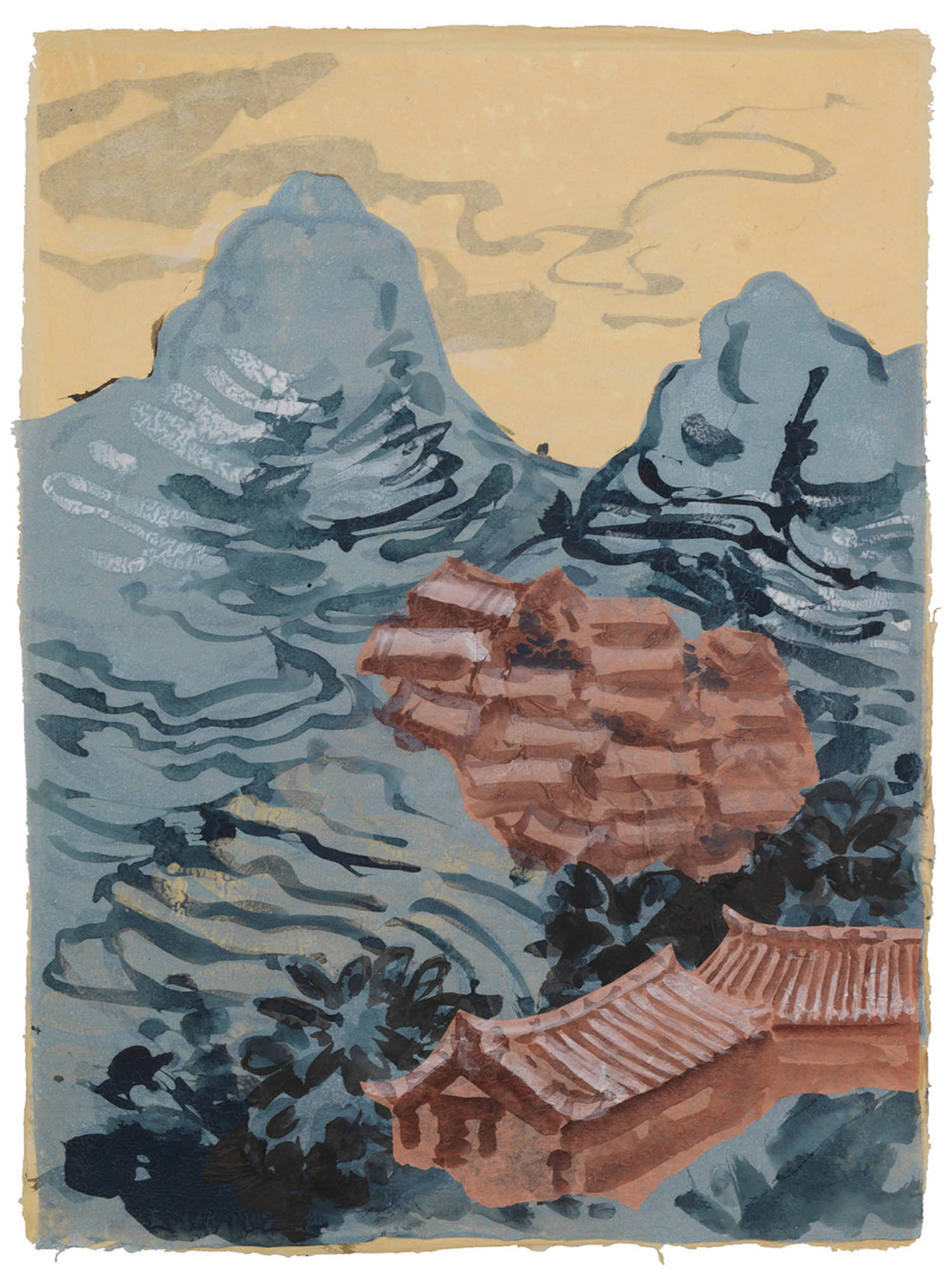
Sigrid Holmwood
WuMu Landscape
2012
Yellow paper made from linen dyed with amur cork tree, blue paper made from linen dyed with indigo fermentation vat, and pink paper dyed with madder roots, painted with caput mortuum, oyster shell white, indigo, Chinese ink and birch leaf pigment bound with parchment clipping glue.
73.5 × 55.5 cm
I wanted to thank He Jie Xian and He Xiu Jun, the two Dongba Shamans, who were also cousins and farmers, for letting us stay with them and teaching us their paper making, so I brought with me a gift of my own handmade watercolours from woad indigo, madder red, cochineal purple, oyster shell white, buckthorn berry yellow and birch leaf yellow each contained in a mussel shell in the tradition of European painters. In order to explain where the colours had come from, I had small samples of each material - some gum arabic, some madder root, some cochineal beetles, an oyster shell, a birch leaf, some buckthorn berries, and a woad seed. It was then that one of the farm workers, He Jie Sai, surprised me; he recognised the woad seed, darting off and returning with a woad leaf and some seeds from their field. It turns out the Chinese have their own species of woad!
However, the Naxi were not growing their woad for indigo dyeing, but rather for medicine. The root, Ban Lan Gen, is considered excellent for boosting the immune system. Indeed, during my journey I searched for translations for the European materials that I use for painting and was surprised to discover that not only did they have some of the same dyes - such as madder roots and indigo - but that they were integral parts of Traditional Chinese Medicine. I wondered how many other plants, native to China, doubled up as dye plants and medicines. As we climbed the mountains around the village in order to harvest the plant used to make Dongba paper, He Jie Xian showed us many other native plants that could be used as colours for painting and dyeing, but which were also used as medicine. One plant had strange prickly leaves and a bright yellow inner bark. He explained in gestures that it was good for your stomach when you are sick, but also for making a yellow dye. Of course, he only knew the name in Naxi, and I had no way of translating it to Latin so I thought I would never see that plant again, but on my return to London, there it was - an imported ornamental plant in my neighbour's front garden... and there it was again, in front of my studio! I now know that in English it is called mahonia, and that the medicinal yellow dye it contains is berberine.
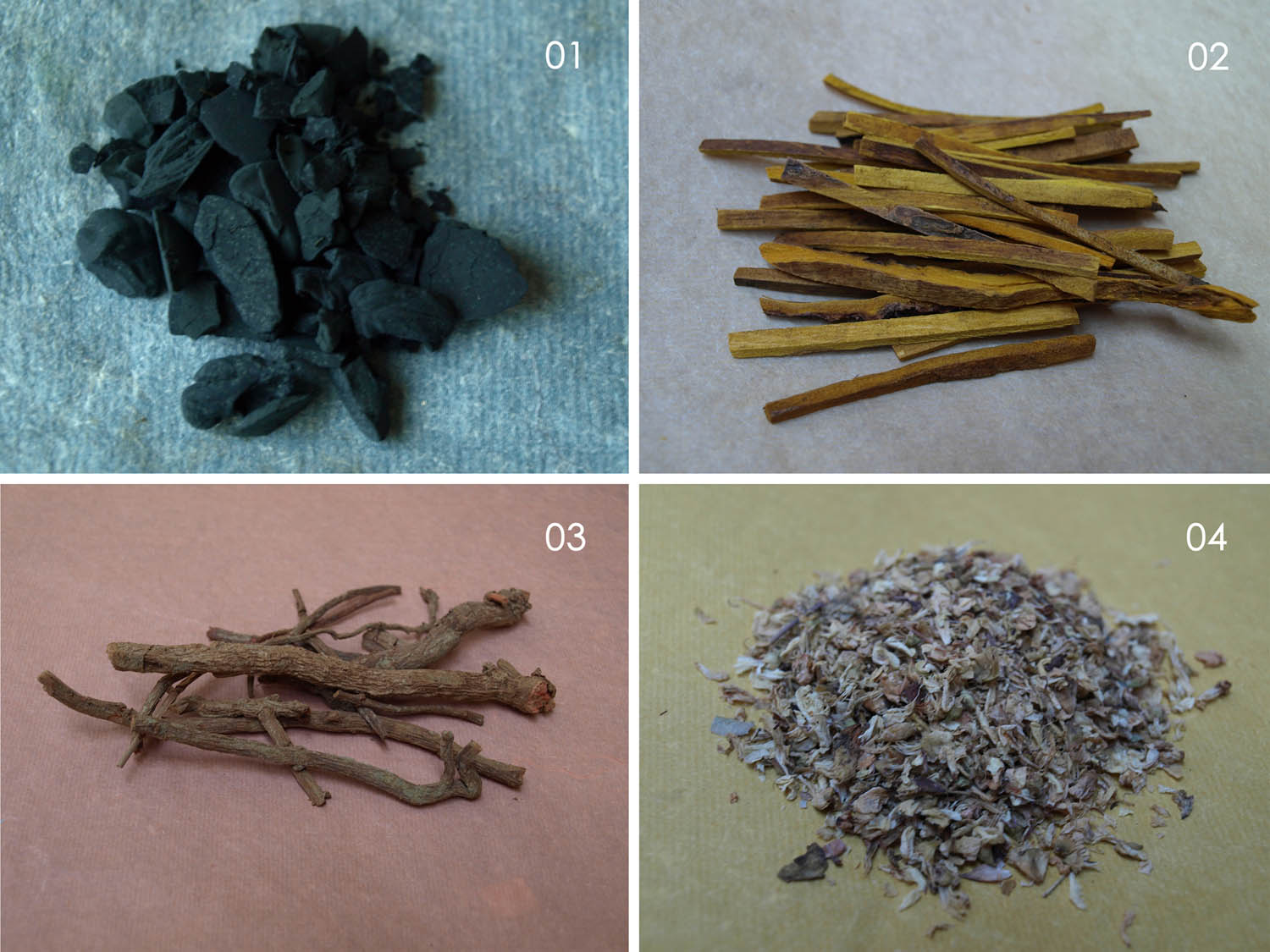
01 Lumps of cooling indigo extracted from Polygonum Tinctoria grown at Little Donkey Farm.
02 Berberine containing amur cork tree bark.
03 Blood-red producing roots of madder.
04 Flowers from the pagoda tree.
The plant which is used for Dongba paper making only grows in that area of China and it does not seem to have been imported to Europe, at least I certainly have not had the fortune to come across it in any gardens of London. The Naxi call it ‘the fragrant Wolf-poison plant’ and it has since taken me some research to ascertain that its Latin name is wikstroemia delavayi, which is part of the same family as the daphnes, thymelaeaceae. Its bark contains a poison that can irritate the skin, but which also repels insects from eating the paper. Incidentally, the two native European Daphnes, D. Laureola and D. mezereum contain a similar irritant, and it has been used in various European folk medicines. Over the days we spent in WuMu, He Xiu Jun guided us through its preparation for paper making, from soaking, to peeling the outer bark from the white inner bark, boiling with soda ash, beating by hand, churning the pulp, and forming the paper into sheets.
Whilst helping He Xiu Jun to peel the bark I used my knife, which is part of my 16th century clothing kit which I had brought with me on my travels to China. My knife is attached to my belt from which also hangs my bag. He Jie Xian liked the look of my bag as it was surprisingly similar to the bags the Naxi old men used to store their tobacco. It was a good moment to get the rest of the 16th century clothes out and for me to put them on and show the Naxi how they worked. It caused much laughter as they thought my woolen dress was ridiculously heavy and hot. He Xiu Jun decided to join in with the dressing up fun and put on his shaman’s robes and headdress. As we sat down in our outfits to peel the bark he explained that it was good to make the paper whilst wearing these clothes as it enhanced the paper and the gods depicted on his headdress would bless the proceedings. Since I too like to dress up, in hand made 16th century peasant clothes, on certain occasions when working, I agreed with He Xiu Jun that what you wear has the power to change the meaning of what you do.
I was not able to fully understand the Naxi people’s Dongba religion. Partly, because of the lack of a common language, and also because they understandably undertook some of their Shaman ceremonies in private, however, I was very aware of a sympathetic magical way of thinking. This could be seen in the importance placed on the Dongba Shaman making his own paper for writing his scripture, and the effect that wearing the Shaman’s clothes had on the paper making. I also noticed certain trees in the mountains and in the village that seemed to have significance, as they had been left to age while others around had been heavily harvested for firewood. In these trees around the Naxi graveyard on the mountain side they had hung bits of wood from the trunks and tucked them into forks of the branches. It seemed that wood was being given back to wood.
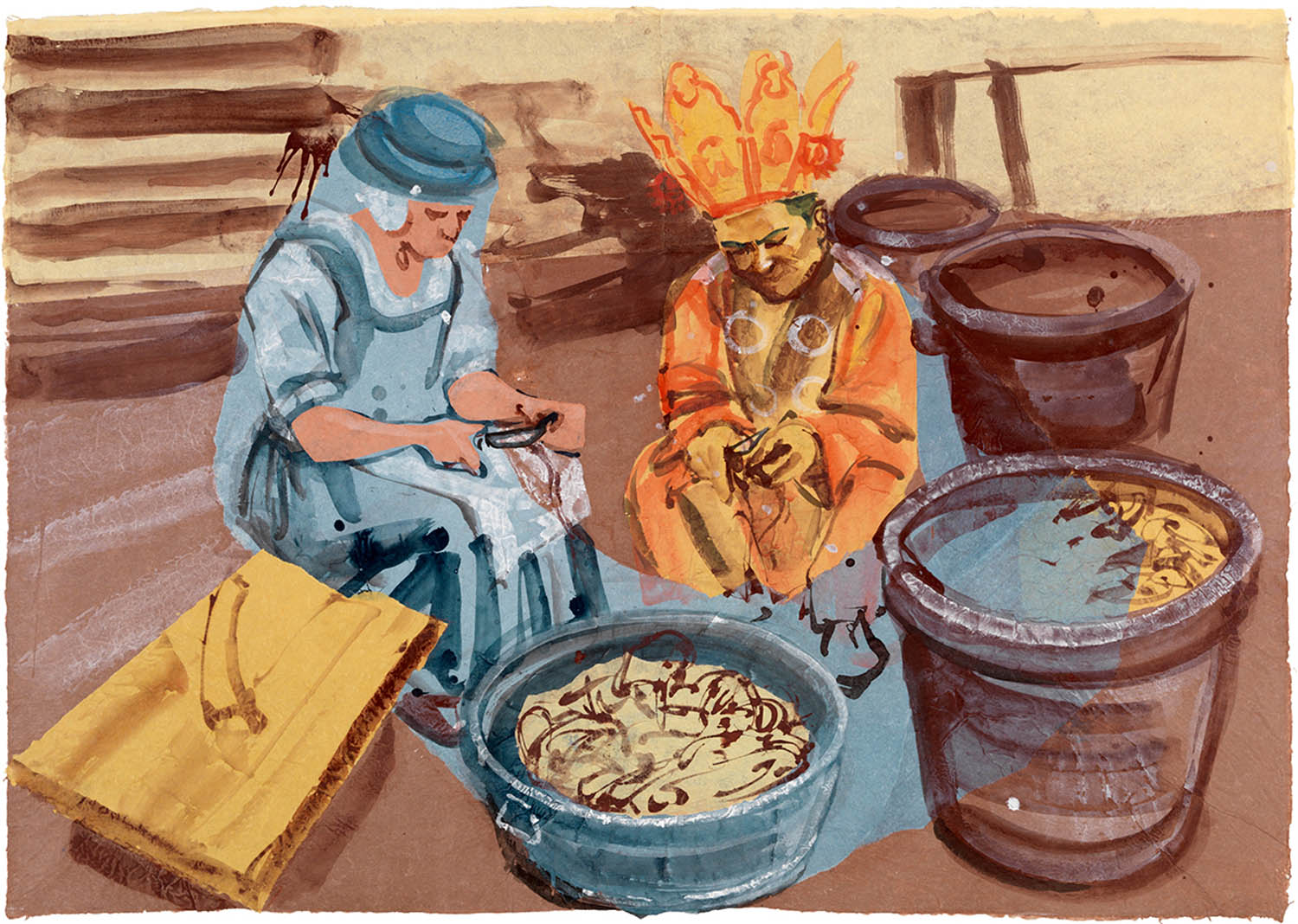
Sigrid Holmwood
Peeling bark
2012
Purple paper made from denim dyed with madder roots and iron, yellow paper made from linen dyed with amur cork tree bark, blue paper made from linen dyed with indigo fermentation vat, pink paper made from linen dyed with madder roots and yellow paper dyed with pomegranate rind and pagoda tree flowers, painted with caput mortuum, vermillion, Chinese ink, oyster shell white, and indigo bound in parchment clipping glue.
100 × 143.5 cm
It dawned on me that this journey was not only teaching me about new materials and cultures, as well as different cultural uses of familiar materials, it was also revealing to me the underlying processes behind my own way of working. I too change the meaning of my work by the clothes I wear, and the act of making my materials by my own hand. I use the origins and stories behind the materials to generate meaning. The colours themselves become characters and protagonists, born out of their materiality. A sympathetic magical way of thinking is not the preserve of so-called ‘primitive’ cultures or ancient religions, it is an integral part of human imagination . Indeed, Daniel C. Noel has argued that rather than seeking to appropriate, and thus inevitably misappropriate, other culture’s traditions of shamanism and magical thinking, Westerners should recognise the imaginative power within their own traditions of literature, and I would add, painting. The mistake made since the Enlightenment in the West is to denigrate the imaginative realm to that of ‘mere’ fiction, and to deny art’s power to access reality. It is similarly a misunderstanding to believe that science is free from magical thinking or could possibly function without the power of imagination.
Return from WuMu
I returned from WuMu to the metropolis of Beijing and onto London with a stack of drawings that I made on my Tudor Group and Nudie Jeans paper, and some samples of Dongba paper, using ochres from the Yulong mountains, indigo harvested from Little Donkey Farm, and a collection of new dye plants that are all a part of Chinese Traditional Medicine. Since the Fragrant Wolf Poison Plant does not grow in Europe, I could not respond to what I learnt on my journey to WuMu by making Dongba paper, indeed, perhaps true Dongba paper can only ever be made by the Naxi in the Yulong mountains. Instead I chose to think magically and make paper coloured with the dyes of Traditional Chinese Medicine - a medicine paper.
Since I was in Europe it was easier to follow the Western method of making paper from fabric, but I decided to give the paper colour by dyeing the fabric before making it into paper. After discovering that many dye plants already familiar to me were also honoured herbs within Traditional Chinese Medicine, I looked for more dye plants native to China and new to me that were also used as medicine. I chose to dye linen and cotton denim for paper making so that I could make use of the different qualities that linen and cotton possess. For my linen, which can make a more translucent paper, I chose a palette of 'primary colours' of indigo blue (qing dai 青黛), pink/red madder root (qian cao 茜草), and yellow amur cork tree bark (huang bai 黃柏). Amur cork tree bark contains berberine, the same dye found in the mahonia He Jie Xian showed me on the mountain, but it is more readily available from Chinese herbalists. It is used to eliminate damp heat. ‘Cooling’ blue indigo is used to cool the blood and is good for psoriasis, while red madder root is used to arrest bleeding and to stimulate menstrual discharge.
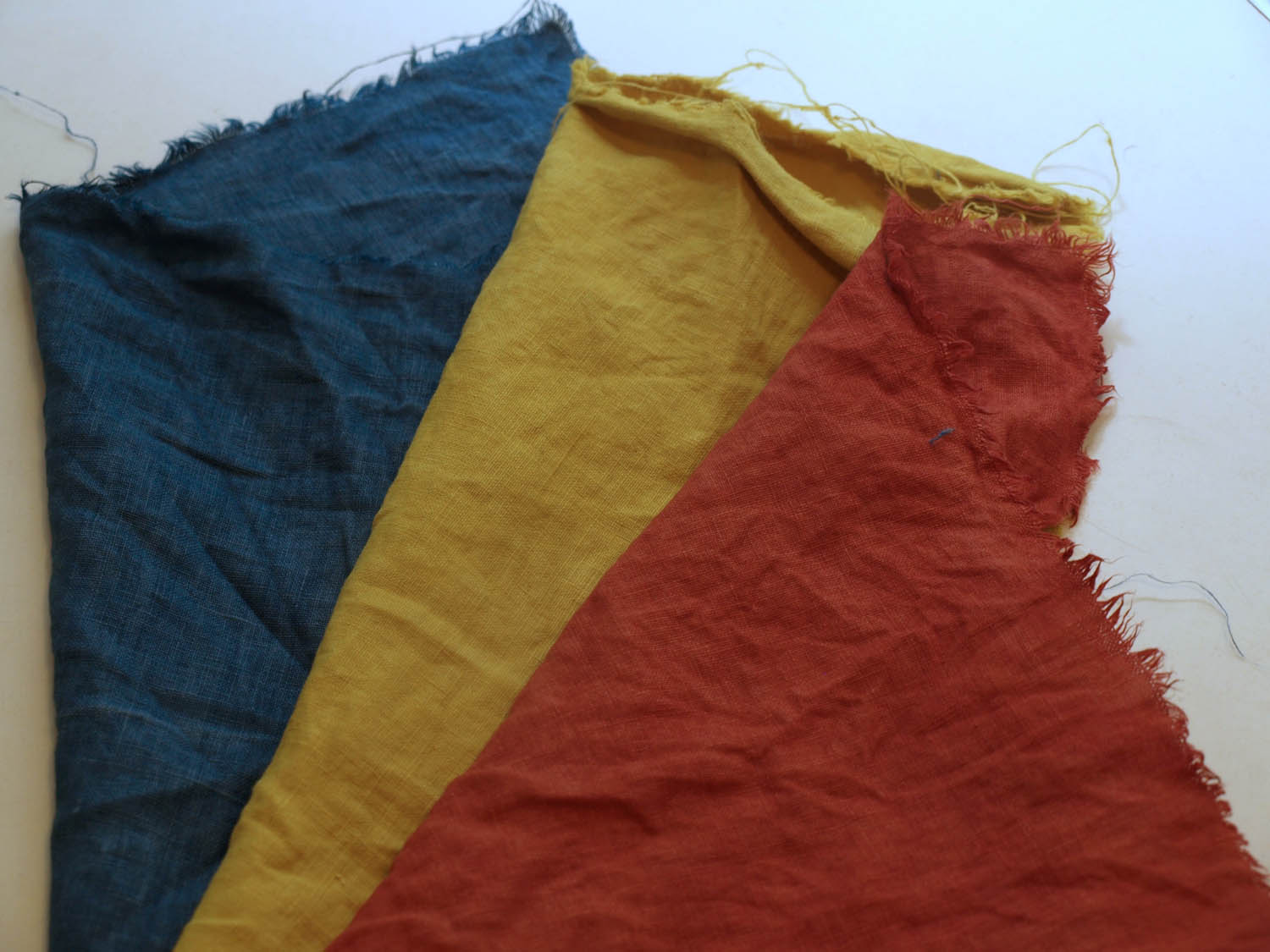
Red madder, yellow amur cork tree and blue indigo linen.
For my cotton denim, I chose a related palette of blue, purple and yellow. The blue came from denim scraps from a factory in Guangzhou, China. While my linen was dyed with a natural indigo using a fermentation vat, the indigo in modern denim is chemically identical but artificially synthesised. I wanted to make present in my paper the Chinese people that have moved from the rural areas to work in clothing factories in the city to make jeans for export to the whole world. The purple was made from madder (qian cao 茜草) modified with iron (铁), and the yellow was made from pomegranate rind (shi liu pi 石榴皮) over-dyed with pagoda tree buds ( Huai Hua Mi 槐花米). During our time in WuMu He Jie Xian’s mother, Yu He, kept feeding us pomegranates from their tree. We would throw the rinds to the little piglets running around the courtyard. However, it turns out that pomegranate rind is a Chinese medicine used for treating diarrhea, worms and hemorrhoids so I imagine the piglets had very healthy bottoms. It is also widely used in East Asia dyeing processes, not only because it is a yellow dye in itself but also because it is rich in tannins and therefore helps other more fugitive dyes bind to the cloth. The Pagoda Tree is also known as the Chinese Scholar Tree, and was often planted around Buddhist temples and at the graves of scholars, much like the Yew tree in Britain. Its name in Chinese is 槐, which is composed of 木 (“wood”) and 鬼 (“demon”)… it seems that there is a spirit in this tree. Its flower buds can be used as an anti-inflammatory and to stem bleeding, but is also a fine yellow dye. Curiously, pomegranate rind and pagoda tree flowers together make a surprisingly strong yellow in comparison to either dye on its own.
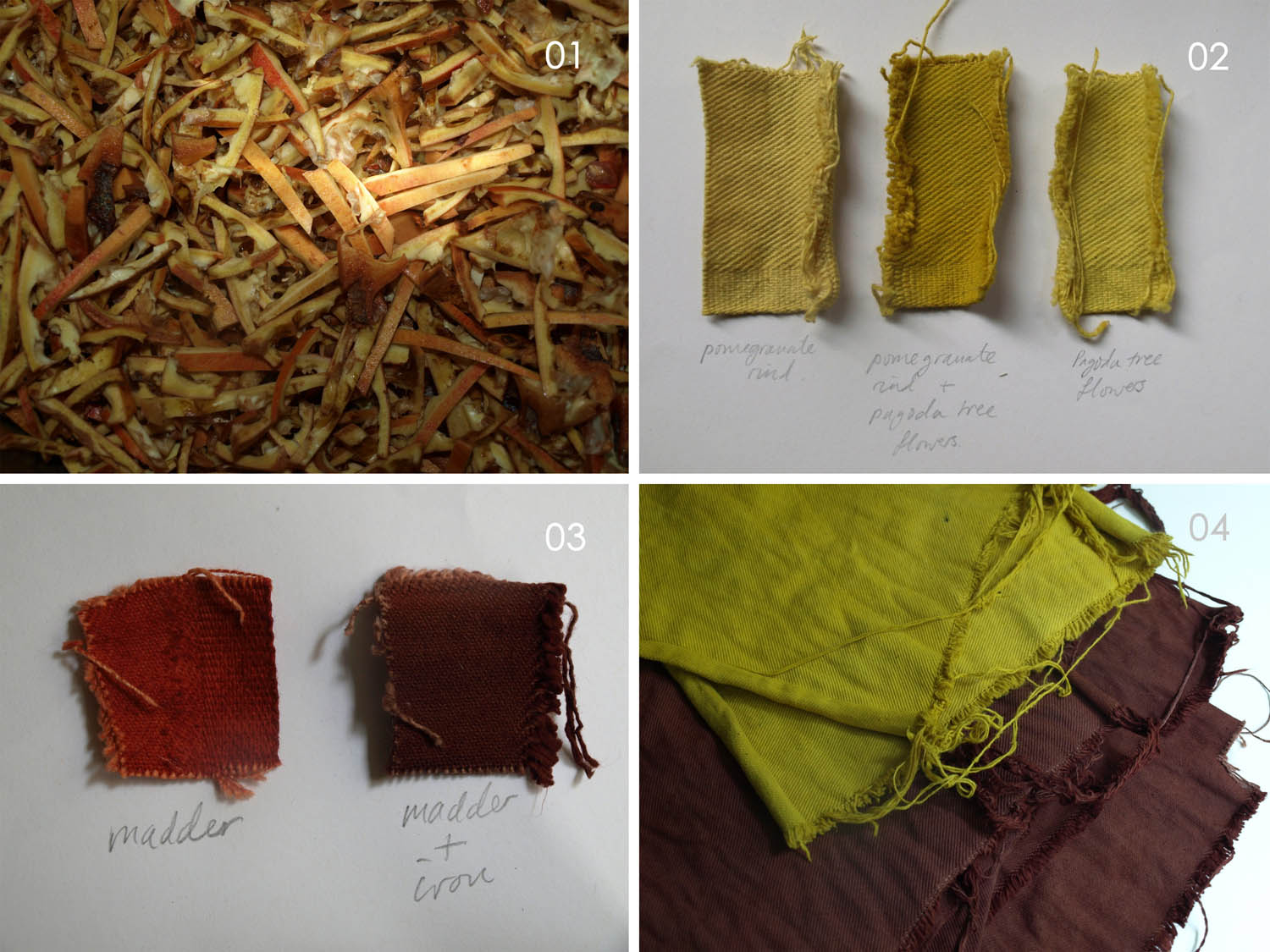
01 Freshly chopped pomegranate rinds.
02 Over-dyeing pomegranate rinds and pagoda tree flowers.
03 Modifying madder with iron.
04 Pomegranate rind and pagoda tree flower yellow and madder modified with iron purple denim.
The dyeing procedure for most of the plants involved a time-consuming process of pre-treating the fabric with tannins and alum in order to make the colour stick to the fabric and increase its lightfastness, a method known as mordanting from the latin, mordere, to bite. The indigo, however, as I have mentioned above is a very special case. Indigo is only blue in its oxygenated state. When oxygenated it is not only blue, but also water insoluble and therefore impossible to use for dyeing. To dye fabric with indigo it must be returned to its water soluble ‘white’ state by removing oxygen. These days there are chemicals such as spectralite that can do this quickly but toxically. Traditionally, in a technique used around the world wherever there is an indigo plant, the indigo is fermented with bacteria which uses up all the oxygen in the vat. There are a number of recipes for an indigo fermentation vat. Many of them use stale urine, but for the sake of those around me I chose the slightly less smelly route of ground madder roots, bran and soda ash. The madder roots and bran provide food for the bacteria to start up the fermentation. In addition, the madder roots tend to have the bacteria on them so they provide the culture at the same time. The soda ash is used to keep the fermentation at an alkali ph around 9 – 10 so that the fermentation does not ‘run away’ and destroy the indigo. The vat is ready for use when it has developed a coppery sheen on the surface, and the liquid is green rather than blue. The fabric does not require mordanting for indigo dyeing, only scouring and wetting. I dipped the fabric for five minutes at a time, making sure not to introduce oxygen to the vat. When it is first pulled out of the vat the fabric is bright green but quickly turns blue in the air in front of your eyes – a magical transformation.
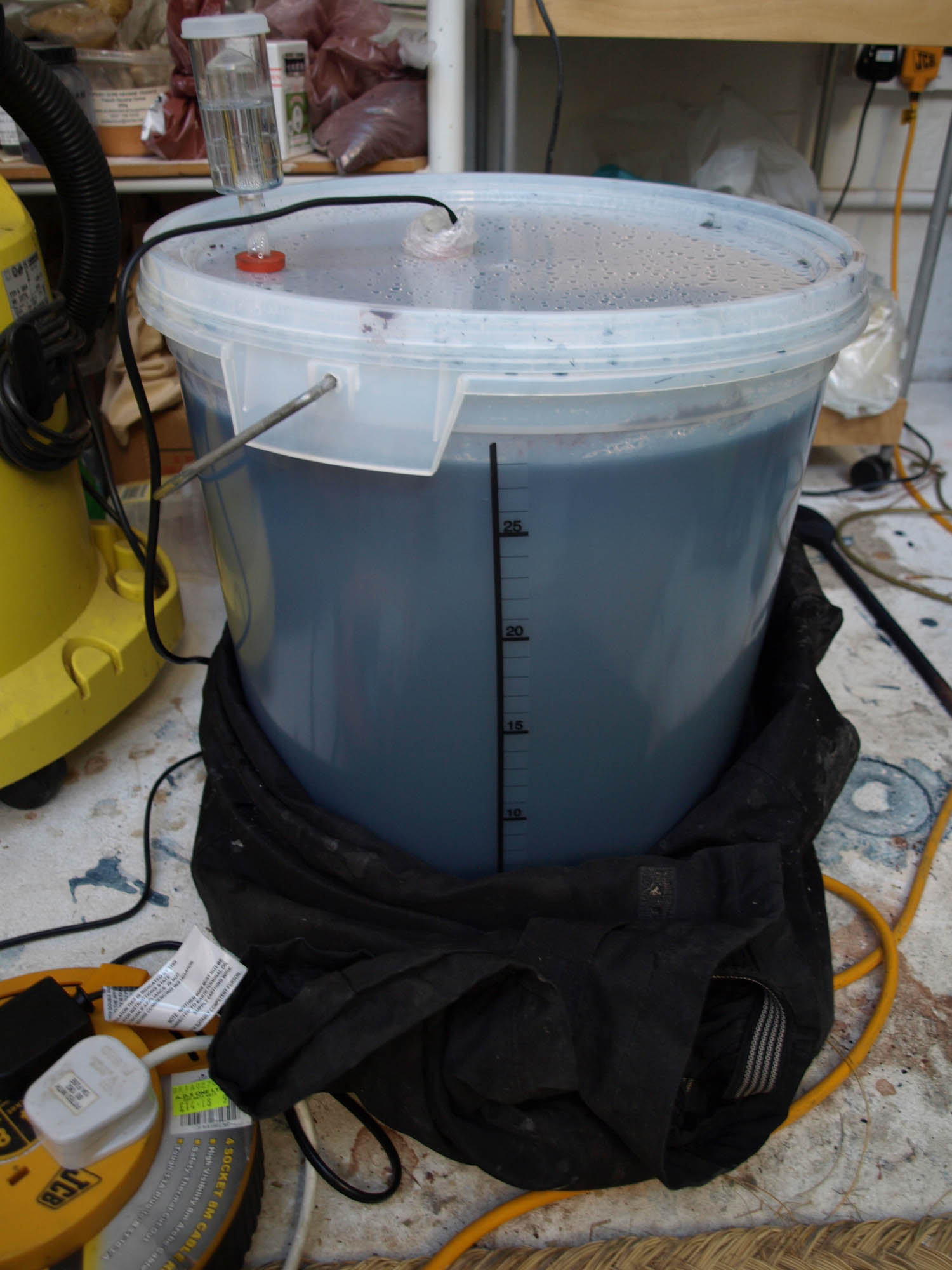
Indigo fermentation vat being kept warm with an immersion heater and a pair of my trousers.
After months of experimentation and dyeing, I was ready to turn to my medicine-coloured rags into paper. For this I had to travel to Glasgow, to the workshop of Alison Newman, Pulp Paper Arts Workshop. She is the only person in the UK to run a workshop where artists can use her facilities and draw on her expertise to make their own paper. I wanted to make big sheets of paper and for this I needed another pair of hands, huge vats and molds, and a big press. Above all, however, I needed a Hollander beater to turn the rags into pulp in the first place. While the Dongba paper in Yunnan, China, could be made by beating the plant fibres by hand, the European method of paper making requires machinery. In the early days this would have been done by water powered stamping machines, but in the 17th century the Dutch invented the wind-powered ‘Hollander beater’, which was more efficient. These days the Hollander beater has changed little in design except that it is powered by electricity instead of wind.
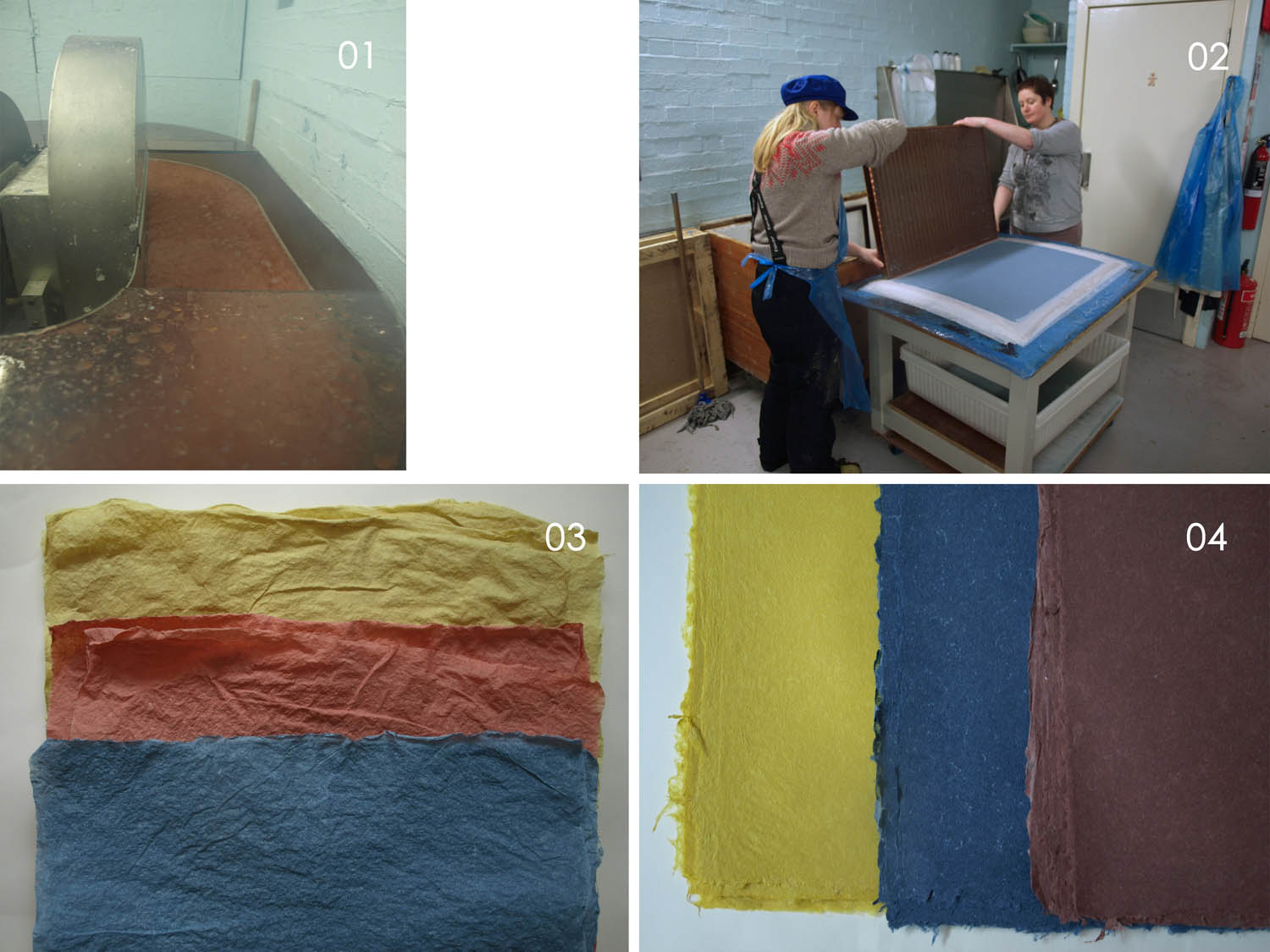
01 Madder dyed linen being beaten to pulp in the Hollander.
02 Making sheets of indigo paper at Alison Newman’s workshop.
03 Yellow amur cork tree linen paper; pink madder linen paper; indigo fermentation vat blue linen paper.
04 Yellow pomegranate rind with pagoda tree flower denim paper; blue denim from a factory in Guangzhou paper; Purple madder saddened with iron denim paper.
I gave the linen more time in the beater than the cotton, in order to make a more translucent paper. I wanted to be able to play with opacity and transparency of colour when painting. It also meant that the pulp had a very high rate of shrinkage making it appropriate for casting three-dimensional forms. With this I cast a Naxi woman's cap from one I had bought in the mountains and sewed an apron in blue paper made from linen dyed in the indigo fermentation vat. Blue worker's caps and aprons were the standard dress for the Naxi women and although they were now made with a bright, synthetically dyed blue polyester, some of the older ladies had indigo aprons and coifs. One could see the working blue being carried forward as a colour tradition even when the original material, indigo, was no longer being used. I also cast a pair of thermos flasks, which I had brought back from China. These giant thermos flasks can be seen all over China always filled with hot water at the ready, not only to make tea, but it is considered very healthy for the stomach to drink hot water with a meal. When casting with paper pulp is a good idea to add size to the pulp in order to strengthen it. For my thermos flasks I sized one with standard potato starch and the other with amflora genetically modified potato starch. Suddenly, in the eyes of many people one of these thermos flasks (I am not telling which one) may seem to be poisoned. This shows just how much sympathetic magical thinking is present in European minds too.
The paint I chose to use with my paper is a distemper – pigments bound with an animal hide glue which in my case I made from parchment clippings. Parchment is of course what was used in Europe before we received the gift of paper. This type of paint has its tradition in both Europe and China, however, it is in Chinese art that it really reached its zenith and power. Considered a cheap and fragile alternative to oil and egg tempera in Europe, it was often used for emulating tapestries, or making stage sets. It was also used in a fine way on linen, but very few examples still survive. In China however, I believe that because they had paper for longer, and indeed such fine paper (and of course, silk), distemper and ink became a far more elaborated and explored materials.
At last the moment came for me to paint. After so many months spent dyeing the fabric and making the paper, it was quite a psychological battle to consider tearing, cutting and painting onto it. The paper itself was imbued with so much thought, time, work and meaning. However, once I was able to overcome my preciousness I found that the time invested in the colouring and making of the paper meant that I was able to paint in a more economical way, and to let the paper breath within the painting. I did not have to cover over the paper in order to satisfy a need to feel that a painting was complete. Indeed, I came to feel that I was painting with paper, rather than on paper. I might have expected that the paintings would represent a final response to my experience in China, but I found that what was revealed to me in the Yulong mountains was a more profound understanding of how working with materials creates meaning. The magic of this ‘medicine’ paper meant that the act of painting, far from representing a journey’s end, instead became a continuation of the journey, carried by materials, through the imagination, onto WuMu and beyond.

Sigrid Holmwood
How to Make Dongba Paper
2012
Woodcut showing how to Make Dongba Paper, printed on Dongba paper, dyed with indigo grown at Little Donkey Farm
20 × 27 cm











